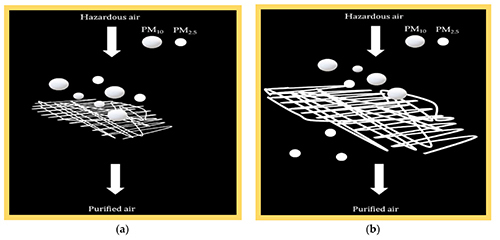© Copyright 2020 Foshan Membrane Technology Co., Ltd. All rights reserved. Sitemap
Particulate Matter (PM) is a general term to classify air pollutants consisting of airborne particles. The particles vary in composition and size, and the sizes of particles range from 2.5 mu m (PM2.5) to 10 mu m (PM10). Anthropogenic activity (e.g., industrial processes or fuel/waste combustion) stands as the main emission source of PM. Due to the fact that indoor PM penetrates from the outside to indoor air, Heating, Ventilation, and Air-Conditioning (HVAC) filtration systems may play a significant role in decreasing air pollution indoors. The section of the respiratory tract affected by particulate matter depends on the particle size. The smaller the fraction, the more deeply it can enter into lungs and bronchi, causing a series of health problems. Conventional electret air filters applied in HVAC systems are not able to efficiently remove PM2.5 (e.g., huge gaps between thick fibers and unintentional elimination of electrostatic effects). The electrospinning process allows for the production of fibers of diverse diameters, including ultrathin yarns. The following work presents the axial length scale chi estimation method for the given conditions and experimental results. According to this approach, it is possible to find out what parameters should be used to produce materials at certain fiber diameters and to capture fine particulate matter fractions (PM2.5). This research refers to poly(acrylonitrile) (PAN) fibers. The most important advantages, limitations, and challenges of the presented methodology are detected and discussed in this work.
颗粒物(PM)是对由空气传播颗粒组成的空气污染物进行分类的总称。颗粒的组成和尺寸各不相同,颗粒的尺寸范围为2.5微米(PM2.5)至10微米(PM10)。人为活动(例如,工业过程或燃料/废物燃烧)是PM的主要排放源。由于室内PM从外部渗透到室内空气中,因此,加热、通风和空调(HVAC)过滤系统可能在减少室内空气污染方面起着重要作用。受颗粒物影响的呼吸道截面取决于颗粒大小。分数越小,它可以越深地进入肺和支气管,引起一系列健康问题。在HVAC系统中使用的传统驻极体空气滤清器无法有效去除PM2.5(例如,粗纤维之间的巨大间隙以及无意消除的静电效应)。静电纺丝工艺可生产各种直径的纤维,包括超细纱线。这项工作介绍了在给定条件下的轴向长度标尺估计方法和实验结果。根据这种方法,可以找出应该使用哪些参数来生产某些纤维直径的材料并捕获细小颗粒物组分(PM2.5)。这项研究涉及聚丙烯腈(PAN)纤维。最重要的优点是,在这项工作中发现并讨论了所提出方法的局限和挑战。

Published: 2021
Journal :APPLIED SCIENCES-BASEL
Impact Factor: No data available
Paper link: https://www.mdpi.com/2076-3417/11/3/1014